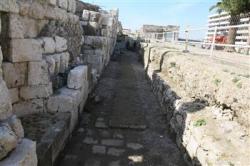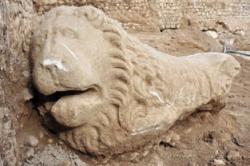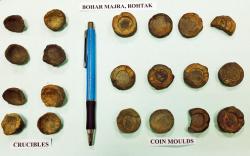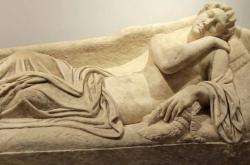INSTITUT SUPERIEUR D'ANTHROPOLOGIE
INSTITUTE OF ANTHROPOLOGY
ONLINE COURSES / COURS A DISTANCE
SPRING TERM : APRIL 2014
REGISTER NOW
TURQUIE –  Izmir - A two-way 60-meter ancient Roman road, which was unearthed in the north of İzmir’s ancient site Agora, has been opened to visits.The excavations in the area are being carried out under the leadership of Professor Akın Ersoy and his team. The team has also revealed a multi-echelon staircase on the street. “The continuation of this staircase goes to an area covered with mosaics. This ancient street is 80 meters long, but it reached the sea. This is the most important street in Agora for the passage of goods. Just like in Ephesus, the street blocks water and has a very good sewer system,” Ersoy said. The first ancient road in İzmir was revealed in a historic market place known as the Silk Road. The second road was found in Agora in Smyrna. There are also four stores that were found on the ancient road.
Izmir - A two-way 60-meter ancient Roman road, which was unearthed in the north of İzmir’s ancient site Agora, has been opened to visits.The excavations in the area are being carried out under the leadership of Professor Akın Ersoy and his team. The team has also revealed a multi-echelon staircase on the street. “The continuation of this staircase goes to an area covered with mosaics. This ancient street is 80 meters long, but it reached the sea. This is the most important street in Agora for the passage of goods. Just like in Ephesus, the street blocks water and has a very good sewer system,” Ersoy said. The first ancient road in İzmir was revealed in a historic market place known as the Silk Road. The second road was found in Agora in Smyrna. There are also four stores that were found on the ancient road.
http://www.hurriyetdailynews.com/roman-road-in-izmirs-ancient-site-agora-opens-.aspx?pageID=238&nID=63054&NewsCatID=375
VIET NAM - Con Co Ngua -Strong evidence has, for the first time, been discovered suggesting that Vietnamese tombs in the central province of Thanh Hoa dated from the early to late period of the Da But civilisation (6,500-4,700 BC), Vietnam News Agency (VNA) reported. According to Dr Trinh Hoang Hiep from the Vietnam Institute of Archaeology, who has worked to uncover the secrets of the province's Con Co Ngua relic site, the unearthed tombstones and grave offerings have shed light on a little-known period in the history of the land. The presence of pottery and stone items, along with the position of uncovered remains, offers valuable information about the Neolithic Era in Vietnam and the region, he stated. A report by the institute published in early 2013 said experts had discovered some 70 ancient tombs, together with bones, teeth and other evidence of animals such as turtles, water buffalo, elk, deer, fish, scallops and oysters. Dating back to at least 5,140-5,520 BC, the Con Co Ngua site - found in Ha Linh commune, Ha Trung district - is one of the most extensive relics left behind by the Da But civilisation in the country, alongside ancient sites in the northern province of Ninh Binh.
http://www.bernama.com/bernama/v7/wn/newsworld.php?id=1018273
ITALIE –  L'Aquila - A lion sculpture was found in the excavation area of Porta Barete, in the town of L'Aquila in Abruzzo. The limestone lion came to light on February 14, and is very similar to others previously found in the area. It is missing its legs, and archaeologists think it was probably paired with another lion, which they are now looking for. The lion was positioned at one of the entrances of the walls, uncovered during the excavations, dating to the late 13th century. Another pair of lions found in the village of Preturo, 6 km from L’Aquila, in 1912 are now kept at the Getty Museum in Malibu, California. The entire area of Abruzzo has revealed several Roman funerary lions during the years.
L'Aquila - A lion sculpture was found in the excavation area of Porta Barete, in the town of L'Aquila in Abruzzo. The limestone lion came to light on February 14, and is very similar to others previously found in the area. It is missing its legs, and archaeologists think it was probably paired with another lion, which they are now looking for. The lion was positioned at one of the entrances of the walls, uncovered during the excavations, dating to the late 13th century. Another pair of lions found in the village of Preturo, 6 km from L’Aquila, in 1912 are now kept at the Getty Museum in Malibu, California. The entire area of Abruzzo has revealed several Roman funerary lions during the years.
http://www.italymagazine.com/news/ancient-lion-statue-found-laquila?
NOUVELLE ZELANDE - Waimakariri. - Contractors have uncovered century-old relics at the site of the new Ashley Bridge in Waimakariri. Ground-clearing work at the bridge on Cones Road unearthed the relics this week. The items include metal shovel heads, pick heads, plates, cups, spoons and a pair of work gloves. Archaeologist Nick Cable says it's likely the relics are remnants of a work camp from around 1912, when the current Ashley Bridge was opened. It's likely some of the pieces will be given to the Rangiora Museum.
http://nz.news.yahoo.com/a/-/top-stories/21746204/century-old-relics-discovered/?
INDE –  Vasai Fort - Debris clearance and excavation by the Archaeological Survey of India (ASI) at Vasai Fort have revealed offices in the town hall and a 15ft-deep well built by the Portuguese in 1606 AD. The ASI has been clearing the debris on the eastern side of the fort that connects the courtroom to the town hall. Here, the remains of at least six offices were found in which the authorities managed several departments. There were three toilets near the courtroom. While two were used by officials, one, built at a much lower level, was used by prisoners. The well with an arch was too used by senior officials. "The wells which were found earlier in the fort have octagonal shapes and they were meant for the use of general public. But this one, which is round and has a stylish arch, was for the higher authorities," said Shridatta Raut, a Vasai historian and writer. Raut added: "The offices built in the town hall managed the day to day affairs, matters of tax etc. Records were also maintained in these offices." According to Raut, the Portuguese used Gothic architecture in the forts developed by them. During the British period, the courtroom was used as a restroom for soldiers. The historian added that complete excavation may reveal numerous artefacts and certain portions could even lead to startling facts about the fort which is still buried in mystery. Out of the 110 acres of the fort area, debris was cleared from only 3 acres.
Vasai Fort - Debris clearance and excavation by the Archaeological Survey of India (ASI) at Vasai Fort have revealed offices in the town hall and a 15ft-deep well built by the Portuguese in 1606 AD. The ASI has been clearing the debris on the eastern side of the fort that connects the courtroom to the town hall. Here, the remains of at least six offices were found in which the authorities managed several departments. There were three toilets near the courtroom. While two were used by officials, one, built at a much lower level, was used by prisoners. The well with an arch was too used by senior officials. "The wells which were found earlier in the fort have octagonal shapes and they were meant for the use of general public. But this one, which is round and has a stylish arch, was for the higher authorities," said Shridatta Raut, a Vasai historian and writer. Raut added: "The offices built in the town hall managed the day to day affairs, matters of tax etc. Records were also maintained in these offices." According to Raut, the Portuguese used Gothic architecture in the forts developed by them. During the British period, the courtroom was used as a restroom for soldiers. The historian added that complete excavation may reveal numerous artefacts and certain portions could even lead to startling facts about the fort which is still buried in mystery. Out of the 110 acres of the fort area, debris was cleared from only 3 acres.
http://www.dnaindia.com/mumbai/report-debris-clearance-reveals-offices-well-at-vasai-fort-1965598?
INDE – 
 Rohtak - Archaeologists have stumbled upon what they believe is an ancient mint that goes back at least a thousand years and might have been lost forever in the rush to build modern houses. Sources in the Archaeological Survey of India said the mint could date back to the Pratihara period, particularly its strongest king Mihira Bhoja I, who ruled in the 9th century AD. The chance discovery, thanks to a retired professor, came at the site of an under-construction housing complex in Rohtak, 70km from Delhi. “Pratihara sites are found in and around Rohtak. This particular site was an ancient mound, where usually archaeologically important objects have been found in past. The site, however, was not protected,” ASI additional director-general B.R. Mani said.rly this month, an ASI team visited the site. “On our first visit on February 2, we found at least 31 moulds close to the surface after which we decided to carry out an extended excavation,” Mani said. On February 15, the ASI began excavating the site, which has yielded 300 coin moulds and several crucibles — measuring containers used to pour molten metal into moulds. “The moulds and crucibles indicate it was a coin minting facility,” Mani said. The ASI has now written to the urban development authority, which owns the site, to hold off construction till the excavation is complete. The ASI has also found a housing complex with several small cells. This is believed to be the mint. The complex is a burnt brick structure and only the southern wall is intact. The cells were probably used by workers to shape the coins. The moulds have the impression of Adivaraha, which, according to Indian mythology, is Vishnu’s boar incarnation, and the epithet Srimad-Adivaraha, which Mihira Bhoja I used as an inscription on his coins. Bhoja, who believed himself to be an incarnation of Vishnu, had adopted the title Adivaraha. He is said to have been the strongest king of the Pratihara dynasty that ruled much of northern India from the 6th to the 11th century AD. Surprisingly, the ASI has neither found any coins from the site, nor molten metal lumps. “It is possible the coins once moulded were taken away from here,” Mani said.
Rohtak - Archaeologists have stumbled upon what they believe is an ancient mint that goes back at least a thousand years and might have been lost forever in the rush to build modern houses. Sources in the Archaeological Survey of India said the mint could date back to the Pratihara period, particularly its strongest king Mihira Bhoja I, who ruled in the 9th century AD. The chance discovery, thanks to a retired professor, came at the site of an under-construction housing complex in Rohtak, 70km from Delhi. “Pratihara sites are found in and around Rohtak. This particular site was an ancient mound, where usually archaeologically important objects have been found in past. The site, however, was not protected,” ASI additional director-general B.R. Mani said.rly this month, an ASI team visited the site. “On our first visit on February 2, we found at least 31 moulds close to the surface after which we decided to carry out an extended excavation,” Mani said. On February 15, the ASI began excavating the site, which has yielded 300 coin moulds and several crucibles — measuring containers used to pour molten metal into moulds. “The moulds and crucibles indicate it was a coin minting facility,” Mani said. The ASI has now written to the urban development authority, which owns the site, to hold off construction till the excavation is complete. The ASI has also found a housing complex with several small cells. This is believed to be the mint. The complex is a burnt brick structure and only the southern wall is intact. The cells were probably used by workers to shape the coins. The moulds have the impression of Adivaraha, which, according to Indian mythology, is Vishnu’s boar incarnation, and the epithet Srimad-Adivaraha, which Mihira Bhoja I used as an inscription on his coins. Bhoja, who believed himself to be an incarnation of Vishnu, had adopted the title Adivaraha. He is said to have been the strongest king of the Pratihara dynasty that ruled much of northern India from the 6th to the 11th century AD. Surprisingly, the ASI has neither found any coins from the site, nor molten metal lumps. “It is possible the coins once moulded were taken away from here,” Mani said.
http://www.telegraphindia.com/1140227/jsp/nation/story_18026554.jsp#.UxDMzPl5PVQ
USA –  New York - Federal investigators on Friday plan to seize an ancient Roman sculpture from a Queens warehouse on behalf of Italian officials who say there is evidence the marble statue of a reclining, half-clad woman valued at $4 million was looted from Italy decades ago. In a complaint filed on Thursday in federal court in Brooklyn, the authorities said the sculpture had served as the lid on an 1,800-year-old sarcophagus of a Roman noblewoman, and was probably looted in the 1970s or early 1980s.
New York - Federal investigators on Friday plan to seize an ancient Roman sculpture from a Queens warehouse on behalf of Italian officials who say there is evidence the marble statue of a reclining, half-clad woman valued at $4 million was looted from Italy decades ago. In a complaint filed on Thursday in federal court in Brooklyn, the authorities said the sculpture had served as the lid on an 1,800-year-old sarcophagus of a Roman noblewoman, and was probably looted in the 1970s or early 1980s.
http://www.nytimes.com/2014/02/28/arts/design/authorities-to-seize-a-roman-statue-in-queens-that-they-say-was-stolen.html?_r=0
PALESTINE – Qumran - The West Bank excavation site Qumran has brought to light another exceptional find after that of the Dead Sea Scrolls. Working on materials from archaeological excavations of the 1950s, archaeologist Yonatan Adler found three phylacteries - pouches used by religious Jews containing small manuscript scrolls with a biblical text - dating back to about 2,000 years ago. A total of nine manuscripts have been found by the Israel Antiquities Authority by using technology known as multispectral imaging, which makes it possible take specialized photos. The discovery was announced at the International TerraSancta Conference on 'Qumran and the Dead Sea Region' held in the Swiss city of Lugano. The conference brought together 65 of the top international experts on Qumran, an archaeological site that garnered international attention in the mid-twentieth century when the 900 documents comprising the Dead Sea Scrolls (also known as the 'Qumran manuscripts') - which date back to between 150 BC and 70 AD - were unearthed there. The three phylacteries are from caves 4 and 5, which were excavated in 1952 by the archaeologist Roland de Vaux. ''It's not every day that you get the chance to discover new manuscripts,'' Adler said. ''It's very exciting.'' The Israel Antiquities Authority is also very pleased about the find. Pnina Shor, tasked with the laboratory for the conservation of the scrolls within the government agency, said that ''I am very proud of the fact that, by using the most advanced technology, we can contribute to reconstructing the history of 2,000 years ago.''
http://www.ansamed.info/ansamed/en/news/sections/culture/2014/02/27/Nine-manuscripts-biblical-text-unearthed-Qumran_10153990.html